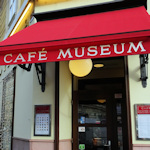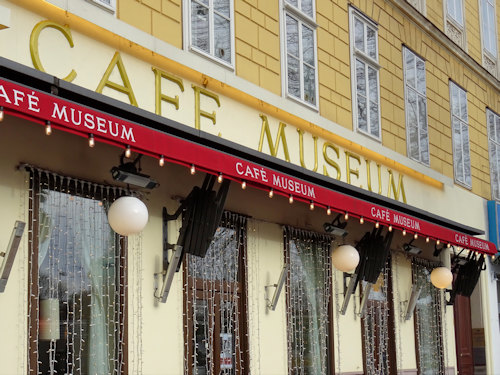
Just a short walk away from the tourist hubbub around the State Opera House is Operngasse, a street housing one of the more notable Vienna cafés: Café Museum provided caffeine-filled sustenance for such artistic revolutionaries as Klimt, Schiele and Loos.
- Once frequented by artists and architects of the early 1900s
- Retains elements of classic mid-20th century décor
- Friendly, unobtrusive service when I visited (and good cakes)
- Book a culinary experience* in Vienna
- See also:
A local review

(Ready for Christmas)
The Café Museum traces its origins back to 1899 and occupies a special place in art history, thanks to the fellow who took care of the interior design. He was Adolf Loos, one of the fathers of modern architecture and active around the time of Viennese modernism.
You can actually see some of the location’s original furniture in Vienna’s furniture museum (the Möbelmuseum).
Loos’s unpretentious, simplistic approach proved a magnet to artists and intellectuals of the time. He himself became a regular guest, as apparently did Otto Wagner, Gustav Klimt, Franz Lehár, Oskar Kokoschka, and Egon Schiele.
I imagine some of the sketches on left-behind napkins were rather intriguing (and would be worth a fortune today).
If you’re a fan of Viennese art and culture around the late 19th/early 20th centuries, then the Secession building is a few steps away, with its Beethoven Frieze by Klimt. And in the other direction is Otto Wagner’s famous station pavilion.
Anyway, my first encounter with Café Museum came at the invitation of a friend. It left enough of a positive impression that I passed on the favour by inviting another friend to join me there for breakfast.
Much of that good impression resulted from the waiters and waitresses, who managed the delicate trick of combining traditional smart attire and service with more contemporary friendliness.
The staff also mastered that arcane skill of appearing unhurried and unobtrusive, yet instantly available when required.
I have no idea how this is done, though I suspect regular sacrifices of coffee beans to the Espresso Gods. They were fast, too: mere moments elapsed between ordering a Wiener melange and running a spoon through the foam topping.
The first thing that strikes you when you enter Café Museum is the brash red and chrome coffee machines at the bar.
The colour combination permeates the premises. Along the walls, for example, red upholstered benches form semi-circles around marbled cream tabletops, creating their own private niches without actually being niches.
Even the little covers that ensure your breakfast egg keeps warm are red. Large silvery balls hang from the vaulted ceiling, while dark coffee house chairs complete the restrained furnishings.
The design stems largely from a 2010 refit, which essentially returned the insides to the style and look of Café Museum in the mid-20th century.
A simple test I have for whether I like a place is the little things. My “Wiener” breakfast – organic egg, organic bread, jam and butter – passed admirably. In particular:
- The butter was not too hard and not too soft, claiming the full 10/10 on the spreadability index
- There was plenty of jam, so no need to panic about how much you dare put on that first roll
(When you get to my age, these things matter.)

(Things have changed since, but this is the billiard room of the café around 1911 in a photo postcard produced by C. Zöhling; Wien Museum Inv.-Nr. 243542; excerpt reproduced with permission under the terms of the CC0 licence)
The “Wiener” was just one of the many meals on offer.
As part of the Querfeld family group, Café Museum also draws on the in-house Landtmann patisserie, which is another way of saying there are some good cakes to go with your coffee.
The prices are not cheap (to say the least): a cappuccino will set you back €6.90 at the time of writing, as will a large beer.
But the value of the top coffee houses is rarely measured in terms of cents and Euros. Plus you really do get to sit there for as long as you like (in my case, four hours with just two coffees).
In summary, Café Museum is stylish, efficient and pristine. The only downside is it might be too stylish, efficient and pristine for some tastes, particularly if you’re looking for a more earthy coffee house experience.
PS
It’s not relevant to a visit today, but it seems worth mentioning that Café Museum helped with public service initiatives while closed during pandemic lockdowns.
For example, they provided a quiet space with Wi-Fi to help kids with home teaching and hosted a free rapid antigen test facility. Respect.
How to get to Café Museum
The coffee house is close to the State Opera House. Which makes it an option for a (quick) post-performance drink.
Subway: If you take the U1, U2 or U4 subway lines to Karlsplatz, the Operngasse exit brings you out more or less at the front door of Café Museum.
Trams and buses: Alternatively, it’s just a short walk from the “Oper/Karlsplatz” stop served by tram lines 1, 2, D, 62, and 71, as well as bus line 59A.
Address: Operngasse 7, 1010 Vienna | Website